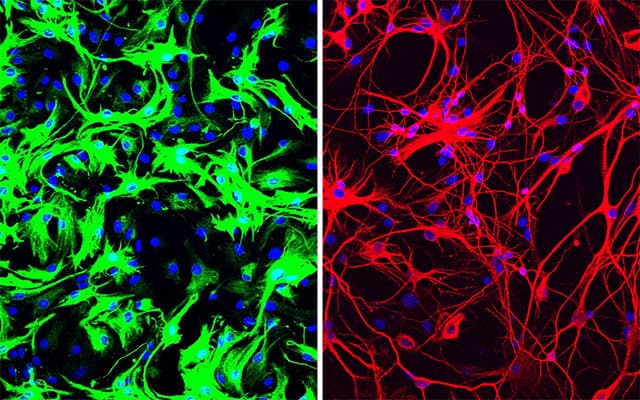There’s good news for people with Parkinson’s disease. A new study shows that deep brain stimulation may not increase the risk of developing dementia. The study is published in the July 1, 2020, online issue of Neurology®, the medical journal of the American Academy of Neurology.
Tag: Parkinson’s Disease

One-Time Treatment Generates New Neurons, Eliminates Parkinson’s Disease in Mice
UC San Diego researchers have discovered that a single treatment to inhibit a gene called PTB in mice converts native astrocytes, brain support cells, into neurons that produce the neurotransmitter dopamine. As a result, the mice’s Parkinson’s disease symptoms disappear.
ISSCR’s first virtual annual meeting opens
More than 1,100 stem cell scientific and industry leaders to share their latest research advances
ISSCR’s first virtual annual meeting opens
More than 1,100 stem cell scientific and industry leaders to share their latest research advances
Parkinson’s Foundation awards nurse faculty grants
Parkinson’s Foundation awards 2020 nurse faculty grant to 3 nurses specializing in Parkinson’s care
Star-shaped brain cells may play a critical role in glaucoma
After a brain injury, cells that normally nourish nerves may actually kill them instead, a new study in rodents finds. This “reactive” phenomenon may be the driving factor behind neurodegenerative diseases like glaucoma, a leading cause of blindness. Led by…
Parkinson’s Foundation awards nurse faculty grants
Parkinson’s Foundation awards 2020 nurse faculty grant to 3 nurses specializing in Parkinson’s care
Star-shaped brain cells may play a critical role in glaucoma
After a brain injury, cells that normally nourish nerves may actually kill them instead, a new study in rodents finds. This “reactive” phenomenon may be the driving factor behind neurodegenerative diseases like glaucoma, a leading cause of blindness. Led by…

New technique allows scientists to measure mitochondrial respiration in frozen tissue
UCLA scientists have developed a method for restoring oxygen-consumption activity to previously frozen mitochondria samples. By speeding up research, investigators hope to accelerate the diagnosis of people living with mitochondrial diseases and secondary disorders in which mitochondria play a key role, including diseases related to aging, metabolism and the heart.
Discover the latest research in stem cell science during ISSCR 2020 Virtual
The global stem cell event kicks off Tuesday, June 23

The Parkinson’s disease gut has an overabundance of opportunistic pathogens
A 2003 hypothesis says Parkinson’s disease is caused by a gut pathogen that could spread to the brain through the nervous system. No evidence was found until now; researchers report for the first time a significant overabundance of a cluster of opportunistic pathogens in the PD gut.
Lancet Neurology publishes results of AFFiRiS’ Phase 1 trial with PD01A in Parkinson’s
Vienna, Austria, June 18, 2020 – AFFiRiS AG, a clinical-stage biotechnology company developing novel disease-modifying specific active immunotherapies (SAITs), today announced that detailed results of the phase 1 clinical program with its lead candidate PD01 in early Parkinson’s disease (PD)…
Innovative multiple-organ devices for brain diseases
Researcher Carmen Giordano received 2 more grants totalling €280,000 for her work on the microbiota-gut-brain axis
New indication of a link between Alzheimer’s and diabetes
High-resolution 3D model reveals strong similarity in fibril structure
Innovative multiple-organ devices for brain diseases
Researcher Carmen Giordano received 2 more grants totalling €280,000 for her work on the microbiota-gut-brain axis
New indication of a link between Alzheimer’s and diabetes
High-resolution 3D model reveals strong similarity in fibril structure
Solving a Parkinson’s disease puzzle through protein design
Dopamine is a neurotransmitter involved in everything from higher cognitive functions to motor control, motivation, arousal, reinforcement, and sexual gratification, the receptors it acts on have been a longstanding target for treating disorders like Parkinson’s disease, which is caused by…
Solving a Parkinson’s disease puzzle through protein design
Dopamine is a neurotransmitter involved in everything from higher cognitive functions to motor control, motivation, arousal, reinforcement, and sexual gratification, the receptors it acts on have been a longstanding target for treating disorders like Parkinson’s disease, which is caused by…
Open Wearables Initiative (OWEAR) releases open source software and datasets database for wearable and connected health technologies
Shimmer Research, a global leader in wearable technology for research applications, today announced that the Open Wearables Initiative (OWEAR) has uploaded its open source software and datasets database for wearable sensors and other connected health technologies to its website at…
Rice team makes tiny, magnetically powered neural stimulator
Tests show ‘magnetoelectric’ power is viable option for clinical-grade implants
Open Wearables Initiative (OWEAR) releases open source software and datasets database for wearable and connected health technologies
Shimmer Research, a global leader in wearable technology for research applications, today announced that the Open Wearables Initiative (OWEAR) has uploaded its open source software and datasets database for wearable sensors and other connected health technologies to its website at…
Rice team makes tiny, magnetically powered neural stimulator
Tests show ‘magnetoelectric’ power is viable option for clinical-grade implants
Growth factors and Parkinson’s disease — Where next?
International experts review the progress of treatment of Parkinson’s disease with growth factors and recommend the design of future trials, reports the Journal of Parkinson’s Disease
New discovery may lead to effective and natural treatment for Parkinson’s disease
Certain hormone-like compounds boost dopamine levels in the brain
Growth factors and Parkinson’s disease — Where next?
International experts review the progress of treatment of Parkinson’s disease with growth factors and recommend the design of future trials, reports the Journal of Parkinson’s Disease
New discovery may lead to effective and natural treatment for Parkinson’s disease
Certain hormone-like compounds boost dopamine levels in the brain
Exceptional stem cell science on tap for ISSCR 2020 Virtual June 23-27, 2020
2020 media registration is open
When astrocytes attack: Stem cell model shows possible mechanism behind neurodegeneration
Human stem-cell-derived astrocytes can be triggered to become toxic to neurons, opening the door for new understanding and treatment of neurodegenerative diseases
Exceptional stem cell science on tap for ISSCR 2020 Virtual June 23-27, 2020
2020 media registration is open
When astrocytes attack: Stem cell model shows possible mechanism behind neurodegeneration
Human stem-cell-derived astrocytes can be triggered to become toxic to neurons, opening the door for new understanding and treatment of neurodegenerative diseases
New gut-brain link: How gut mucus could help treat brain disorders
Changes in gut mucus could be contributing to bacterial imbalance and exacerbating core symptoms of brain disorders like autism, Parkinson’s disease, Alzheimer’s and Multiple Sclerosis
Researchers develop new method to map cholesterol metabolism in brain
A team of researchers led by Swansea University have developed new technology to monitor cholesterol in brain tissue which could uncover its relation to neurodegenerative disease and pave the way for the development of new treatments
Modified Parkinson’s drug shows potential in treating nonalcoholic fatty liver disease
Scientists spur advances in fatty liver disease therapy by modifying an existing neurological drug
Modified Parkinson’s drug shows potential in treating nonalcoholic fatty liver disease
Scientists spur advances in fatty liver disease therapy by modifying an existing neurological drug
Molecular pair offers potential for Parkinson’s treatment, finds NTU Singapore-Harvard study
A promising molecular pair has offered hope that could lead to the development of a new treatment to slow down Parkinson’s disease, a study by Nanyang Technological University, Singapore (NTU Singapore) and Harvard University has found. Parkinson’s disease is the…
Molecular pair offers potential for Parkinson’s treatment, finds NTU Singapore-Harvard study
A promising molecular pair has offered hope that could lead to the development of a new treatment to slow down Parkinson’s disease, a study by Nanyang Technological University, Singapore (NTU Singapore) and Harvard University has found. Parkinson’s disease is the…
Unique insight into development of the human brain: Model of the early embryonic brain
We know a lot about the human brain, but very little about how it is formed. In particular, the stages from the second to the seventh week of embryonic development have so far been virtually unknown territory to brain researchers.…
Scientists find evidence of link between diesel exhaust, risk of Parkinson’s
UCLA study uncovers how air pollution can lead to damage to brain cells
Cutting edge two-photon microscopy system breaks new grounds in retinal imaging
Retina is the only part of the central nervous system (CNS) that can be visualized noninvasively with optical imaging approaches. Direct retinal imaging plays an important role not only in understanding diseased eye and ocular therapeutic discovery, but also study…
Cutting edge two-photon microscopy system breaks new grounds in retinal imaging
Retina is the only part of the central nervous system (CNS) that can be visualized noninvasively with optical imaging approaches. Direct retinal imaging plays an important role not only in understanding diseased eye and ocular therapeutic discovery, but also study…

Scientists find evidence of link between diesel exhaust, risk of Parkinson’s
A new UCLA study in zebrafish has identified the process by which air pollution can damage brain cells, potentially contributing to Parkinson’s disease.
GlycoNet welcomes $16.3 million renewed federal funding
This funding extension will support glycomics research to improve the quality of life of patients across Canada
Novel treatment using patient’s own cells opens new possibilities to treat Parkinson’s disease
Reprogramming a patient’s own skin cells to replace cells in the brain that are progressively lost during Parkinson’s disease (PD) has been shown to be technically feasible, reports a team of investigators from McLean Hospital and Massachusetts General Hospital (MGH)…
Significant differences exist among neurons expressing dopamine receptors
An international collaboration, which included the involvement of the research team from the Institut de Neurociències of the UAB (INC-UAB), has shown that neurons expressing dopamine D2 receptors have different molecular features and functions, depending on their anatomical localization within…
Novel treatment using patient’s own cells opens new possibilities to treat Parkinson’s disease
Reprogramming a patient’s own skin cells to replace cells in the brain that are progressively lost during Parkinson’s disease (PD) has been shown to be technically feasible, reports a team of investigators from McLean Hospital and Massachusetts General Hospital (MGH)…
Significant differences exist among neurons expressing dopamine receptors
An international collaboration, which included the involvement of the research team from the Institut de Neurociències of the UAB (INC-UAB), has shown that neurons expressing dopamine D2 receptors have different molecular features and functions, depending on their anatomical localization within…

Scientists show MRI predicts the efficacy of a stem cell therapy for brain injury
Scientists at Sanford Burnham Prebys Medical Discovery Institute and Loma Linda University Health have demonstrated the promise of applying magnetic resonance imaging (MRI) to predict the efficacy of using human neural stem cells to treat a brain injury—a first-ever “biomarker” for regenerative medicine that could help personalize stem cell treatments for neurological disorders and improve efficacy. The study was published in Cell Reports.
COVID-19 may compound the social and economic burdens of Parkinson’s disease
Evidence from past epidemics and preclinical research suggests that the COVID-19 pandemic may have a long-lasting impact on the pandemic of Parkinson’s disease, scientists write in the Journal of Parkinson’s Disease
Researchers find the ‘brain’s steering wheel’ in the brainstem of mice
Walking is one of the most important motor skills for animals and humans. And for almost all people, being able to walk is deeply essential. In spite of this, researchers are still working to map out which signals and electrical…
Predictive models could provide more accurate detection of early-stage Parkinson’s disease
TORONTO, May 11, 2020 – How is your sense of smell? Do you find yourself frequently dozing off during the day or thrashing about during dreams? Often, early stage Parkinson’s disease does not present with typical motor disturbance symptoms, making diagnosis…